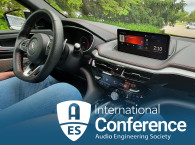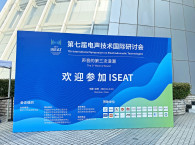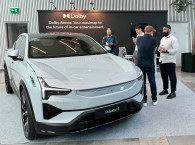
Common to all AES conferences is the prevalence of academic and scientific research while allowing very few presentations from the industry itself. Companies sponsoring the events are allowed to exhibit and promote demonstrations, as well submit papers and posters as long as those not contain blatant commercial references. Unfortunately, the strict presentation format doesn't encourage participation from manufacturers with interesting stories to tell. The obsession to avoid commercial-oriented or corporate-related presentations, in my opinion, undermines the main purpose for those who attend, in terms of getting an updated overview of the state of technology. An AES conference should be a space for sharing knowledge, absent from corporate messages and sales promotions - that's perfectly understandable - but because of this orientation, unfortunately the content doesn't reflect the situation in the field.
In the end, this was reflected in the conference, lacking in critical technology areas such as transducer design, materials, and consumer market research in general, which would be the perfect complement for the elevated scientific research that was presented. Of course, the interchange between academic researchers and the companies attending is extremely valuable and creates an excellent opportunity for recruiting new engineering talent - and I am certain this was one of the key aspects at this particular event.

Test and measurement companies, able to focus their marketing efforts on education, and a few companies large enough to "sponsor" the time for their dedicated research and development teams (and willing to actually encourage external engagement), are some of the notable exceptions. Not surprisingly, some of those companies - such as Harman, Dolby, Sennheiser, and GoerTek Audio Technologies - were among the event sponsors and were directly present with product demonstrations, apart from contributing with presentations.
The dichotomy becomes all too apparent when, following the presentation by G.R.A.S. Sound & Vibration, which detailed the advantages in terms of extended frequency response and dynamic range of the new G.R.A.S. 43BB acoustic coupler and benefits in test repeatability with in-ear products of the new G.R.A.S. KB5000 soft silicone pinna (see audioXpress review here), the reaction from most of the scientific research community in the audience was cold and in some cases even hostile. While companies from all over the world seem to be reacting to this solution by placing more orders than G.R.A.S. is able to fulfill, many research and academic institutions are reacting to the fact that this exposes the limitations of existing studies dependent on the current standard 711-couplers used for testing headphones, earphones, hearing protectors, hearing aids, etc.

Other conference sponsors included Bragi, Comsol, Oxford Digital, Jabra or even the municipality of Struer, promoting is "City of Sound" project. Struer is where Bang & Olufsen is based, and its municipality has developed a project to maintain and renew that DNA in the region, in direct co-operation with Bang & Olufsen, IMG, and Aarhus2017, European Capital of Culture.
All in all, the conference program was wide-ranging and the organization promoted an exceptional event. The summer weather was beautiful in Aalborg during the three days (albeit unexpectedly warm and humid), and the attendance quality was extremely high, allowing for great networking opportunities.
The event also provided some great demonstrations, which clearly indicate that the industry is pushing innovation faster. While many of the papers focused on binaural audio systems and head-related transfer functions (HRTF), essential to realize an immersive listening experience over headphones unique for every individual, the demonstration by Smyth Research of its Realiser A16 3D audio headphone processor (Kickstarter campaign) was the best possible indication of what the future will hold. The Smyth Virtual Surround (SVS) 3D sound processing technology that drives the Realiser A16 allows for an absolutely perfect emulation of surround/immersive sound (Dolby Atmos content was used in my demo session) and virtually any loudspeaker system and sound room in headphones, combining also personalization and tracking of the user's movements.

Most of the conference sessions focused on perception, sound personalization, and augmented reality with headsets/headphones, but demonstrations from companies such as Harman's virtual headphone evaluation, Hefio's self-calibrating headphones, or Bragi's demonstration of its wireless earbuds with built-in sensors allowing for head-tracking, confirm that those technologies are getting closer to becoming mainstream.
The pace of innovation in the study of hearing and perception, present in the majority of the papers, are another indicator that efforts currently focusing on headphones and binaural reproduction will also award major contributions toward loudspeakers design. All the current research being done in terms of new concepts, technologies, and possibilities for consumer headphones - sharing many aspects in common with audiology - could also translate to useful concepts, technologies, and possibilities in loudspeakers.

One of the frequent topics addressed in the papers points toward transposing much of the research being done in headphones/earphones to hearing aids and "hearing-enhancers." Still, participants at this international conference seemed to agree that medically prescribed audiology products would remain a separate segment, even if it will soon be possible for consumers to access hearing-enhancing solutions that, in practice, could become important aids for the large percentage of the population that doesn't acknowledge needing a hearing aid: a fascinating perspective for a truly "augmented reality" future.
Of course, the 2016 AES International Conference on Headphone Technology was also full of great presentations, which we intend to detail in a dedicated report and maybe in future editions of The Audio Voice. Just the papers proceedings, without the keynote presentations, are 233 pages. Too much to even list in this space. I am quite certain the AES will schedule a follow up to this Headphone Conference soon, this time allowing for a larger attendance and more product presentations.
www.aes.org/conferences/2016/headphones/
This report was originally published in The Audio Voice newsletter 96, September 1.







